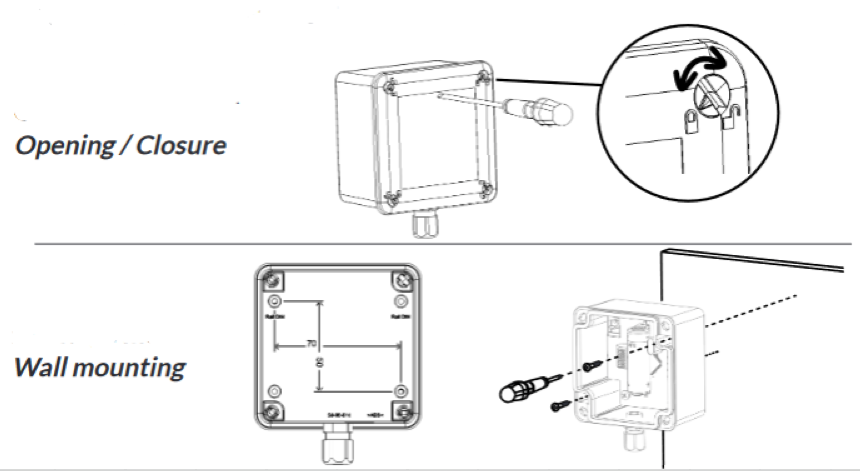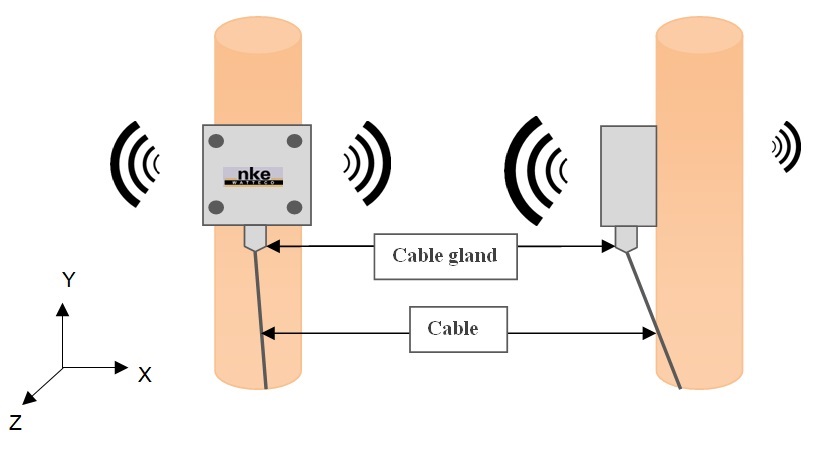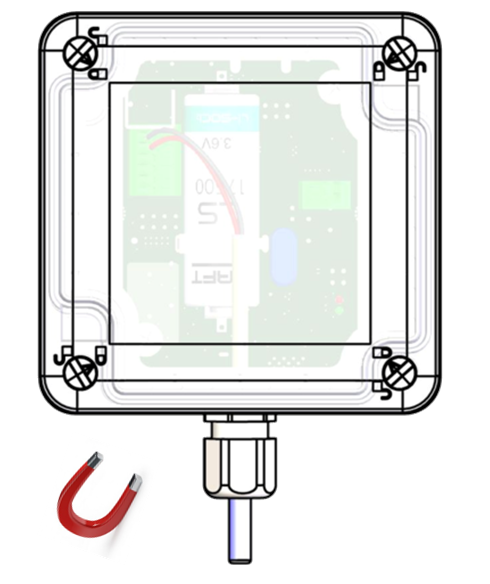Remote Temperature and Humidity Outdoor
Presentation
The Remote Temperature and Humidity sensor is a LoRaWAN class A device that uses a disposable 3.6V A-type battery as power supply. It also includes an internal antenna.
It measures the temperature, the relative humidity of the remote sensor. It is possible to get the voltage of the power supply. The device is outdoor waterproof.
| Accuracy tolerance | |
|---|---|
| Temperature (°C) | +/- 0.2 |
| Humidity (%) | +/- 2 |

Family code
The family code of Remote Temperature and Humidity devices is: 50-70-200
LoRaWAN release
v1.0.2 Region Parameter rev B
User guide
Installation and operation
Installation

Radio propagation
In order for the sensor to operate correctly, the number of obstacles should be limited in order to avoid excessive radio wave attenuation. It is also important to place the sensor as high as possible.

Autonomy
The information in the table below represents how long the battery can last. It is based on the default configuration at ambient temperature (+25°C) within the optimal operating range of the sensor via a LoRaWAN network (one uplink frame), when the spreading factor used is SF12.
The disposable battery has a 3.6Ah capacity, of which 85% is used.
| Transmission and Measure periodicity | Spreading Factor | Battery life |
|---|---|---|
| 12 hours / 1 hour | 12 | 10 years |
| 2 hours / 30 min | 12 | 10 years |
| 1 hour / 10 min | 12 | 7 years |
| 1 hour / 10 min | 9 | 10 |
Human Machine Interface
There are two LEDs on the device:
Green: blinking until the association with a network is done.

Red: blinking in configuration mode.
To start up the device, a magnet must be placed next to the sensor for one second (to the left of the cable gland). The red LED blinks quickly during this step. After one second, the red LED stops blinking and the green LED blinks slowly until the association is done.
To switch off the device, repeat the same operation by placing the magnet next to the sensor for 5 seconds. After those 5 seconds, the red LED blinks 5 times slowly.
A reed switch is available under the sticker. A magnet can be used to activate it and perform specific actions on the sensor (switch off, switch on, reassociation…). When the reed switch is activated, the red LED blinks quickly.

- Configuration

| Way to trigger it | One passage of the magnet near the reed switch or specific ZCL command |
| Way to stop it | Another passage of the magnet or specific ZCL command |
| Effects on the sensor | The CONF led (red) blinks (3 sec. OFF, 3 sec. ON) and the sensor sends an uplink frame every minute. |
| Duration | The configuration mode lasts 10 minutes |
- A reassociation procedure can be requested if no downlink frame is received by the sensor during a given periodicity (4 days by default) or if a given number (100 by default) is reached or in case of failure (no acknowledgement received) by sending an applicative frame to the sensor or via the sensor’s IHM.
The sensor keeps the AppEUi and DevAddr configured, Confirmed/Unconfirmed configuration and all applicative configurations. However, LoRaWAN configurations (channel, data rate …) are lost.
| Way to trigger it | Three passages of the magnet near the reed switch or ZCL command from LoRaWAN cluster. |
| Effects on the sensor | The ASSN led (green) blinks as the “no commissioned sensor” LED is lit. |
- A factory reset is available on Watteco’s sensors. It deletes all the applicative settings saved in the flash memory (i.e. configured batches and reports will be deleted).
The sensor keeps the AppEUi and DevAddr configured. However, LoRaWAN configurations (channel, data rate…) and applicative configurations are lost.

| Way to trigger it | Two quick passages and a long passage of the magnet near the reed switch |
| Effects on the sensor | The CONF LED (red) and ASSN LED (green) blink at the same time briefly. All the applicative settings (for batches and reports) are deleted. The blinking is illustrated below this table. |
Applicative layer
Codecs are available to decode frames: Downloads
The Temperature and Humidity device integrates the following clusters:
| Cluster | Cluster name | Managed attributes |
|---|---|---|
| 0x0000 | Basic | All |
| 0x0050 | Configuration | All Threshold is available |
| 0x8004 | LoRaWAN | All |
| 0x0402 | Temperature Measurement | All Threshold is available |
| 0x0405 | Relative Humidity Measurements | All Threshold is available |
The binary input is available and connect to the opening of the casing.
Default configuration
A default configuration is set:
- The device reports a "standard" of temperature / humidity from every 4 hours. It makes a measure all 10 minutes and sends a report if measure goes to a threshold of <15°C or > 30°C or <> 60%. The battery is send each 24 hours.
A configuration of batch could be used as described below :
| Features | Label (size= 2) | Measure periodicity | Transmission periodicity | resolution |
| Temperature | 0 | 10 minutes | 1 hour | 0.1°C |
| Relative Humidity | 1 | 10 minutes | 1 hour | 1% |
| Battery Voltage | 2 | 7 days | 7 days | 1mV |
To decode this configuration "batch" is necessary to use this argument: 2 0,10,7 1,100,6 2,1,6 3,1,1 .
Every change made to the default configuration must comply with the legal duty cycle (for example, the most restrictive in the EU is 0.1%, which corresponds to approximately 1 frame per hour with SF12)
Measurement periodicity
The measurement periodicity depends on the minimum and maximum recording intervals, and the delta.
If the value of the minimum and the delta is 0, then the maximum value is the periodicity. However, if the value of delta is different than 0, then the periodicity is 1 second.
If the value of the minimum is different than 0, then this value is the same as the periodicity.
Frame examples
All frames have to be sent on port 125
Standard report
Report
Report of the temperature of the remote sensor → Applicative payload is: 11 0a 04 02 00 00 29 00 64 00 64: Measured value 1°C (Temperature (°C) = Measured value/100)
Report of the relative humidity of the remote sensor → Applicative payload is: 11 0a 04 05 00 00 21 03 20 03 20: Measured value 8% (Relative humidity (%) = Measured value/100)
Batch
Report of a batch → Applicative payload is: 220000C081938297B457C0140108D009645E1968B707 {
"batch_counter": 0,
"batch_relative_timestamp": 3670,
"batch_absolute_timestamp": "2020-11-19T09:34:13.289",
"dataset": [
{
"data_relative_timestamp": 1870,
"data": {
"value": 2654,
"label": 0,
"label_name": "Temperature"
},
"data_absolute_timestamp": "2020-11-19T09:04:13.289Z"
},
{
"data_relative_timestamp": 3670,
"data": {
"value": 2434.0,
"label": 0,
"label_name": "Temperature"
},
"data_absolute_timestamp": "2020-11-19T09:34:13.289Z"
},
{
"data_relative_timestamp": 1870,
"data": {
"value": 2712,
"label": 1,
"label_name": "RelativeHumidity"
},
"data_absolute_timestamp": "2020-11-19T09:04:13.289Z"
},
{
"data_relative_timestamp": 3670,
"data": {
"value": -34588.0,
"label": 1,
"label_name": "RelativeHumidity"
},
"data_absolute_timestamp": "2020-11-19T09:34:13.289Z"
}
]
}
Configuration
Modify report on the temperature Modify the periodicity of measure to 5 minutes and sending all 30 minutes of temperature. The frame is : 1106040215000000803c803c0000000a02 →Response: 11 07 04 02 00 00 00 00 To disable the previous configuration, change the value of the minimum and maximum sending intervals and the delta to 0

